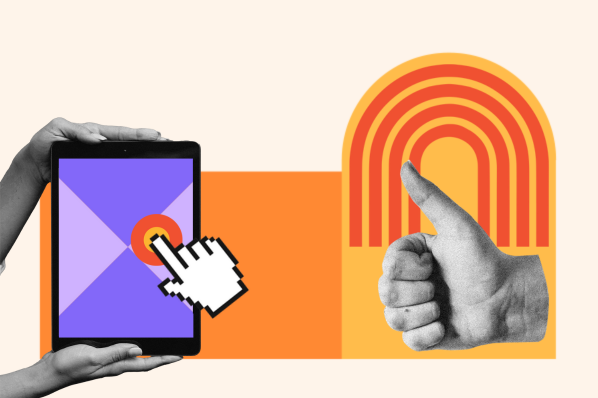The role of the User Experience (UX) researcher is growing in demand as more organizations recognize UX research's massive impact on business.
User satisfaction is now a critical metric for business success, as more than 4 out of 5 respondents in this survey said they would stop business with a brand they loved after just three or fewer instances of bad experiences.
Now more than ever, it’s critical for companies to design and deploy products, services, and even websites with the end-user in mind. Collecting, analyzing, and interpreting the data needed to make this possible is called user experience (UX) research — a very in-demand position. A quick look for UX researcher jobs on LinkedIn shows more than 200,000 open positions nationwide.
Download Now: 25 Free HTML & CSS Hacks
But what exactly is UX a researcher? What are they doing all day? What’s the difference between UX researchers and designers — and how do you become a UX researcher if you’re interested in this career?
This article will cover the basics and highlights and help you better understand the UX researcher’s role.
What is UX Research?
The Interaction Design Foundation defines UX research as “the systematic investigation of users and their requirements, in order to add context and insight into the process of designing the user experience.”
That’s a mouthful, but the role of UX research is straightforward: discovering what end-users want digital and physical experiences to look like based on observation, behavior monitoring, and direct interaction.
What’s a UX researcher?
UX researchers work to understand consumer needs as they relate to company products or services. This includes identifying target markets, uncovering key motivations, and determining the best design approach to improve end-user satisfaction.
What does a UX researcher do?

UX researchers use qualitative and quantitative data to discover best-fit design principles and approaches.
For example, researchers might use qualitative measurements such as satisfaction surveys to identify potential satisfaction shortfalls or leverage quantitative metrics such as e-commerce cart abandonment rates to analyze the impact of online experiences.
Or they can use qualitative methods to understand why users behave as they do. Qualitative research can be done through field studies, user interviews, usability tests, and observations.
To acquire relevant customer data, UX researchers use multiple methods.
- Direct observation: UX researchers observe customers interacting with existing products or services for information about how these experiences could be improved. For example, they may observe how users interact with website layouts that don’t work or service descriptions that aren’t clear and then determine potential remedies to help inform future designs.
- Interviews: Speaking one-on-one with consumers helps UX researchers drill down and discover precisely where experiences don’t measure up. These interviews typically combine pre-formatted questions and freeform interactions to get customers thinking about potential UX issues but also give them the freedom to describe their personal experiences.
- User surveys: Surveys help UX researchers reach a broad sample of target customers at once. These surveys may be multiple-choice or short-answer and generally focus on a single aspect of user experience to help drive specific feedback.
- Usability tests: Once preliminary research is complete, UX designers often create product or service prototypes based on customer feedback. UX researchers can then conduct usability tests with these initial experience iterations to see how users respond and discover potential prototype shortfalls.
- A/B tests: These tests show users different versions of a website, product, or offer. The UX researcher tracks the effectiveness of the design of the site or variations in the product on consumer behavior and conversion.
Once data has been collected and analyzed, UX researchers develop customer experience theories highlighting key findings and suggesting design best practices to maximize user satisfaction. UX designers then use these theories to create optimized UX components. For example, Gartner reports that 74% of respondents consider creating a seamless customer journey “very important.” UX research plays a critical role in making this seamlessness possible.
It’s an exciting role with above-average monetary compensation as well, with a UX researcher earning an average of $100,000 annually.
Benefits of UX Research
Some of the reasons many organizations turn to UX research include:
- UX research helps organizations understand how users experience assets like websites, mobile apps, products, and others.
- UX research unearths new customer needs and business opportunities.
- It helps them discover and fix flaws in products and offerings.
- UX research increases understanding of every stage in a customer’s buying journey.
UX Researcher vs. UX Designer
While UX researchers and UX designers share the same broad goal — improving the end-user experience — their roles are substantially different.
UX researchers focus on the underlying motivations, needs, and expectations of end-users. It’s their job to discover these critical human components using the research methods above and then create theories that address key concerns and suggest ways to adapt current products, services, or web experiences.
UX designers, meanwhile, convert the broad theories of UX researchers into actionable designs and experiences. In effect, UX researchers develop and draft the basic form of enhanced UX while designers build the function.
What’s this like in practice? Consider an e-Commerce site experiencing a disconnect between full customer shopping carts and sales conversions. UX researchers look at reasons why — are prices or shipping details unclear? Are there too many steps between item selection and payment? Is the website slow or cumbersome?
UX designers use UX research findings to identify what can be changed. This might include a more streamlined Product to Cart to Purchase experience or an improved backend infrastructure to enhance overall performance.
How to Become a UX Researcher
UX researchers look to develop end-user theories based on three key methodologies: observation, understanding, and analysis. While no specific qualifications are required to become a UX researcher, you’ll need to develop key skills that align with each of these categories.
- Observation: This requires a keen eye for detail and the ability to organize data into relevant categories quickly. Observant UX researchers are trained to identify pain points in the user experience even if customers don’t actively voice their frustration.
- Understanding: Emotional aptitude and conversational ability are critical to driving understanding. Researchers conducting one-on-one interviews must put customers at ease and ask the right questions to zero in on key concerns.
- Analysis: UX researchers must also be comfortable with handling and analyzing data at scale to create trend-based models around user satisfaction. In addition, they need the confidence to design and deploy new models quickly — even if they don’t work as intended — and learn from their mistakes.
Stand-out UX researcher candidates often have a Master’s degree or Ph.D. in Sociology or Psychology.
However, UX researcher Nikki Anderson shared in her interview with UX collective that you don’t necessarily need one.
-2.webp?width=650&height=222&name=Untitled%20(3)-2.webp)
If you’re determined to embark on a career in UX research, you must have a solid foundation of knowledge before jumping into the waters. With your background in related areas like psychology, sociology, etc., you can learn the fundamentals of user research by using online resources like:
While knowing the theory and concepts is vital, it’s worth gaining experience on the design and implementation side — enterprises will want to see evidence of your ability to understand, analyze and interpret customer needs. Jakob Nielsen, the co-founder of the Nielsen Norman Group, said in a recent interview, “the best way of learning UX is by doing UX.”
Touhid Kamal, a UX researcher at Delivery Hero, also gives the following tips regarding starting a career in UX research:
-1.webp?width=650&height=140&name=Untitled%20(4)-1.webp)
Finding a mentor might seem daunting, but you increase your chances of linking up with one by attending a UX research conference or a local meeting. You can find a list of 80 upcoming conferences on UX research here.
It might be challenging to jump right into a UX research career, especially without previous experience. If that’s your situation, Anna Efimenko, Senior UX researcher at UXinsight, recommends “... consider starting off in a different role. There may be potential to grow in the future, or opportunities to learn from UX researchers at the organization.”
UX Research: The Bottom Line
UX research underpins customer satisfaction — and is now critical to driving long-term business success. As a result, skilled UX researchers are in-demand to help companies improve the user experience, capture consumer interest and improve sales conversion.
Once you have the skills needed, it’s time to look for a job in the UX field. It’s a quickly growing profession that lies at the heart of the tech industry. With huge upward potential and opportunities for people of different backgrounds and skills, a career as a UX researcher can be exciting and rewarding.
Editor's note: This post was originally published in April 2020 and has been updated for comprehensiveness.
User Experience




![How to become a UX designer, a step-by-step guide [expert tips]](https://53.fs1.hubspotusercontent-na1.net/hubfs/53/become-a-ux-designer-1-20240731-321437.webp)


![How to Add a Parallax Scrolling Effect to Your Website [Examples]](https://53.fs1.hubspotusercontent-na1.net/hubfs/53/scroll-Aug-11-2023-05-24-08-8793-PM.png)

![20 UX Design Examples Hand-Picked by Experts [With Analysis]](https://53.fs1.hubspotusercontent-na1.net/hubfs/53/ux-design-examples-1-20250404-8425368.webp)
